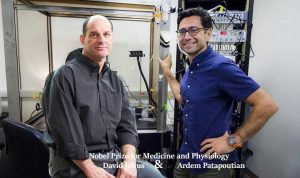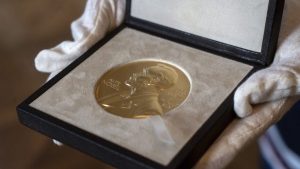Science has made a potentially major leap in its battle against chronic pain and strides towards addressing the opioid crisis, thanks to the efforts of David Julius, a professor at the University of California, San Francisco (UCSF), and a Howard Hughes Medical Institute (HHMI) Trustee, and Ardem Patapoutian, an HHMI Investigator at Scripps Research.
The two researchers made major discoveries about pain receptors involving heat and pressure, respectively. As a result, both Julius and Patapoutian have received the Noble prize in medicine for their work. As reported in the Associated Press (AP), “Americans David Julius and Ardem Patapoutian separately identified receptors in the skin that respond to heat and pressure, and researchers are working on drugs to target them.”

Current Pain Research Limited
While we currently understand the basic neuronal aspects of how our bodies react to pressure and temperature, we are unsure of what is precisely involved at the level of molecules. These biological processes, which Julius and Patapoutian have uncovered, may be the missing link that will complete our understanding of these phenomena.
As the Nobel Prize committee frames it, “Prior to the discoveries of David Julius and Ardem Patapoutian, our understanding of how the nervous system senses and interprets our environment still contained a fundamental unsolved question: how are temperature and mechanical stimuli converted into electrical impulses in the nervous system?”
Patapoutian’s and Julius’ findings go a long way to answering this fundamental question. “These sensations of heat and pain and touch, if those are all converted to electrical signals and sent to the brain, that opens up a whole new world of potential treatments,” explains Chad Bouton, a professor at the Feinstein Institutes for Medical Research in New York.
The Struggle to Understand Pain Receptors
However, Patapoutian’s achievement did not come about without significant frustrations. In fact, it was not until Patapoutian and his colleagues tested the 72nd gene that they were successful in pinpointing the molecular proteins involved in relaying pressure. To determine the specific gene and protein involved, they used a technique of switching off the cell while poking its membrane and recording its activity, isolating each gene until they found corroborating evidence.
After a year’s work, they eventually discovered that gene 72 was not sensitive to poking, leading them to conclude that a “mechanosensitive receptor had been discovered.”
Pain and Ion Channels
Specifically, Patapoutian’s work “led to the discovery of two more ion channels, named Piezo1 and Piezo2, which are activated by pressure.” This was a pivotal discovery because ion channels facilitate the passive movement of ions down an electrochemical gradient and across lipid bilayers in cells. Without ion channels, our bodies would not have a way of converting nervous system signals into a molecular process, which is an ongoing dynamic needed for not only survival but daily optimal daily functioning.
As the National Center for Biotechnology Information (NCBI) puts it, “This phenomenon is essential for life, and underlies many critical homeostatic processes in cells.” Patapoutian’s discovery has been corroborated by additional studies, with the Nobel Committee writing that, “Further studies firmly established that Piezo1 and Piezo2 are ion channels that are directly activated.”
The Importance of Touch and Pain
Along with our sense of sound in the embryo, which is muted because we are encased in embryonic fluid, our sense of touch is rooted in our primeval development. As such, it plays a crucial role in how we interact with and learn from our environment. Moreover, it is intimately connected to how we individuate ourselves, a psychological dynamic that Jung posited is necessary for full emotional maturation.
According to the British Psychological Society, “Just before the eighth week of gestation, an embryo may develop sensitivity to tactile stimulation (e.g. Bernhardt, 1987; Gottlieb, 1971) – it begins to touch. Whereas the visual system requires prolonged development in order to become fully effective, the sense of touch is perhaps the primordial matrix upon which the awareness of ourselves as individuals, separated from the external world, starts to form.”
Moreover, our sense of touch is deeply connected to other aspects of our physiology. The Howard Hughes Medical Institute (HHMI) states “The sensing of mechanical forces and their translation into chemical signals influence a variety of biological processes,” and “Hearing depends on mechanosensation, and the sensory modality also controls the function of the heart, blood vessels, lungs, and kidney.”
Pain and Futrue Reserach
This is why Patapoutian’s discovery is so important, as it promises not only to impact the field of chronic pain but open up new paths of research that will likely change how we treat a plethora of medical conditions. One example is that Patapoutian and his team “found that red blood cells [RBCs] can sense pressure and adjust their volume accordingly,” according to HHMI.
Because RBCs become distorted during infections, such as COVID-19, Patapoutian’s work may eventually shed new light on vascular and hematological aspects of treatment, as some evidence points to COVID-19 being a vascular and hematological disease.
Pain and Heat
Julius’ discoveries involving how our bodies process heat are equally groundbreaking. According to the publication Nature, “Physiologist David Julius at the University of California in San Francisco (UCSF) used capsaicin — the compound that gives chilli peppers their gustatory kick — to track down a protein called TRPV1 that responds to painful heat.”

Much like Patapoutian’s quest, Julius and his team’s search for capsaicin sensors also drilled down to the genetic level. As HHMI explains: “In the lab, Julius’s team added single fragments of DNA into cells that were not sensitive to capsaicin. Then, they added the chemical to the cells and recorded their activity. By testing millions of DNA fragments, Julius was able to identify the gene that made the cells able to detect capsaicin.”
Another parallel is that Julius and his colleagues also examine the role of ion channels. As Patrik Ernfors, an adjunct member of the Nobel Committee, describes, “He had discovered a temperature-sensitive ion channel activated by heat that is perceived as painful.” The specific heat receptor Julius found is Transient receptor potential vanilloid type (1TRPV1). The Nobel Prize committee states that “The discovery of TRPV1 was a major breakthrough leading the way to the unravelling of additional temperature-sensing receptors.”
Recent investigations indicate that TRPV1 “underlies pain hypersensitivity in neuropathic pain,” which means that Julius’ work may have applications to a plethora of neuropathic pain conditions, such as postherpetic neuralgia, trigeminal neuralgia, painful radiculopathy, diabetic neuropathy, HIV infection, leprosy, amputation, peripheral nerve injury pain and stroke.
And, given the presence of neurological problems associated with COVID-19, such as Guillain-Barré syndrome (which affects nerves), transverse myelitis (which affects the spinal cord), and acute necrotizing leukoencephalopathy (which affects the brain), this new-found knowledge may help treat those that developed COVID-19 long haul issues.
Pain and the Opioid Crisis
The promise of pain reduction that underly these discoveries by Julius and Patapoutian are profound. The Centers for Disease Control (CDC) report that as of 2019, “20.4% of adults had chronic pain and 7.4% of adults had chronic pain that frequently limited life or work activities (referred to as high impact chronic pain) in the past 3 months.”
So pervasive are issues with chronic pain that it has “been linked to restricted mobility, opioid dependency, anxiety, depression, and reduced quality of life, and it contributes to an estimated $560 billion annually in direct medical costs, lost productivity, and disability programs in the United States” according to the National Center for Complementary and Integrative Health (NCCIH).
Opioid dependency, which often leads to heroin use, has become an epidemic in the United States. The U.S. Department of Health and Human Services (USDHHS) reports that “More than 760,000 people have died since 1999 from a drug overdose” and “Two out of three drug overdose deaths in 2018 involved an opioid.” Furthermore, the American Association of Nurse Anesthesiology found that “Overdose is now the #1 cause of death in people under 50.”
Fiona Boissonade, a pain specialist at the University of Sheffield, sees the discoveries by Patapoutian and Julius as a potential game-changer with regard to addressing these addiction issues connected to pain, stating, “pain is a huge medical problem, and it’s quite poorly treated across the board,” adding, “Their research may lead us to identify new compounds that are effective in treating pain that don’t come with the devastating impact of opioids.”
What is the Future of the Discoveries?
Richard Harris, of the Chronic Pain and Fatigue Research Center at the University of Michigan, is cautiously optimistic, saying, “Their discoveries are giving us the first inkling of how this type of pain starts, but whether it’s involved in many chronic pain patients remains to be seen.”
Patapoutian and Julius beat out a multitude of other medical scientists who were competing for the coveted prize, many of whom had discoveries related to COVID-19, making the duo’s award even more notable in a world that is dominated by research related to the virus.
At Newsweed.com, we adhere to three simple principles: truth, balance, and relatability. Our articles, podcasts, and videos strive to present content in an accurate, fair, yet compelling and timely manner. We avoid pushing personal or ideological agendas because our only agenda is creating quality content for our audience, whom we are here to serve. That is why our motto is ”Rolling with the times, straining for the truth.”
Your opinion matters. Please share your thoughts in our survey so that Newsweed can better serve you.
Charles Bukowski, the Los Angeles beat poet that captured the depravity of American urban life once said, “There is something about writing poetry that brings a man close to the cliff’s edge.” Newsweed is proud to stand in solidarity and offer you a chance to get close to the cliff’s edge with our first Power of Poetry Contest. Are you a budding bard, a versatile versifier, a rhyming regaler? Do you march to the beat of iambic pentameter, or flow like a river with free verse? If so, here’s your opportunity to put your mad poetic chops to the test. Enter our poetry contest for bragging rights and an opportunity to win some cash!






